2001 CHRYSLER VOYAGER sensor
[x] Cancel search: sensorPage 3970 of 4284
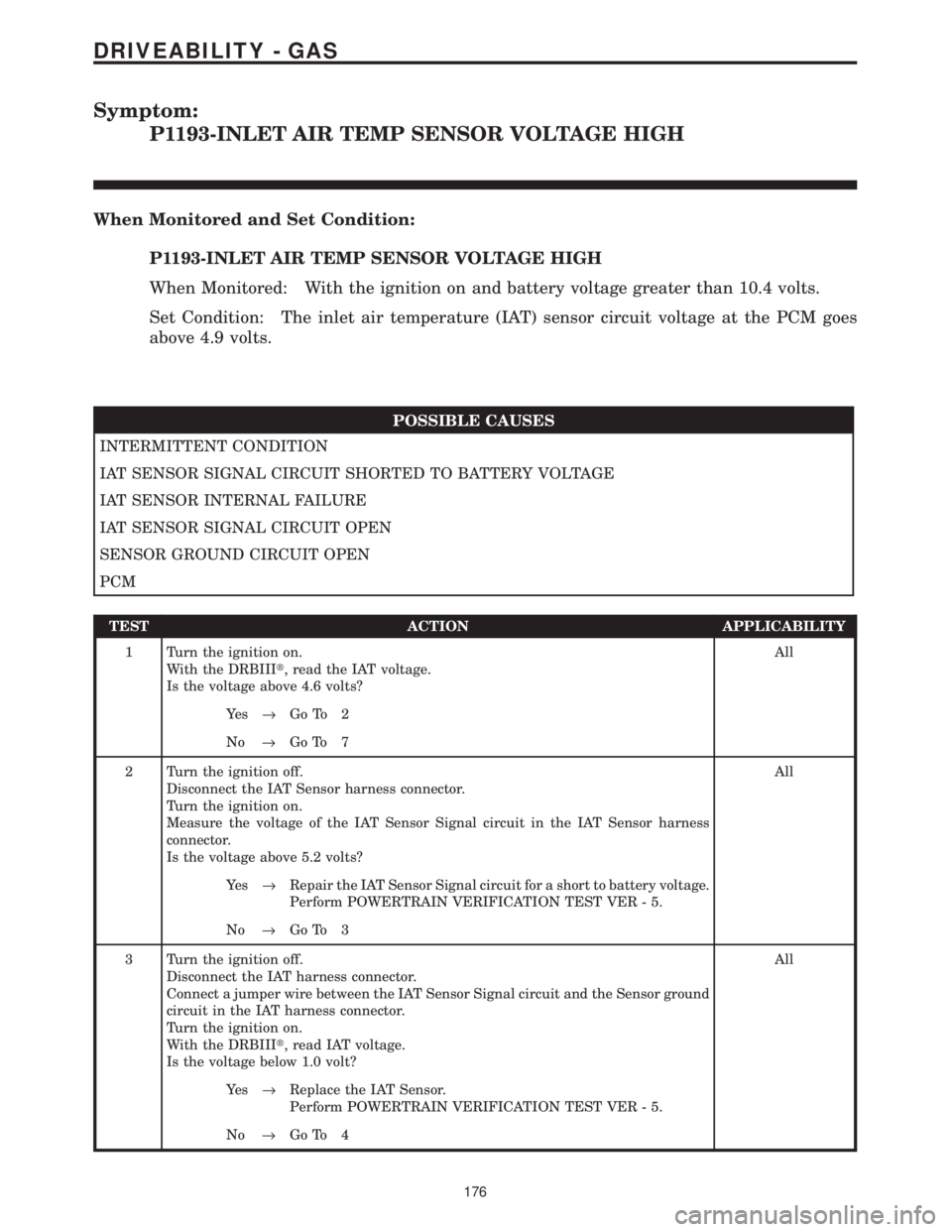
Symptom:
P1193-INLET AIR TEMP SENSOR VOLTAGE HIGH
When Monitored and Set Condition:
P1193-INLET AIR TEMP SENSOR VOLTAGE HIGH
When Monitored: With the ignition on and battery voltage greater than 10.4 volts.
Set Condition: The inlet air temperature (IAT) sensor circuit voltage at the PCM goes
above 4.9 volts.
POSSIBLE CAUSES
INTERMITTENT CONDITION
IAT SENSOR SIGNAL CIRCUIT SHORTED TO BATTERY VOLTAGE
IAT SENSOR INTERNAL FAILURE
IAT SENSOR SIGNAL CIRCUIT OPEN
SENSOR GROUND CIRCUIT OPEN
PCM
TEST ACTION APPLICABILITY
1 Turn the ignition on.
With the DRBIIIt, read the IAT voltage.
Is the voltage above 4.6 volts?All
Ye s®Go To 2
No®Go To 7
2 Turn the ignition off.
Disconnect the IAT Sensor harness connector.
Turn the ignition on.
Measure the voltage of the IAT Sensor Signal circuit in the IAT Sensor harness
connector.
Is the voltage above 5.2 volts?All
Ye s®Repair the IAT Sensor Signal circuit for a short to battery voltage.
Perform POWERTRAIN VERIFICATION TEST VER - 5.
No®Go To 3
3 Turn the ignition off.
Disconnect the IAT harness connector.
Connect a jumper wire between the IAT Sensor Signal circuit and the Sensor ground
circuit in the IAT harness connector.
Turn the ignition on.
With the DRBIIIt, read IAT voltage.
Is the voltage below 1.0 volt?All
Ye s®Replace the IAT Sensor.
Perform POWERTRAIN VERIFICATION TEST VER - 5.
No®Go To 4
176
DRIVEABILITY - GAS
Page 3971 of 4284
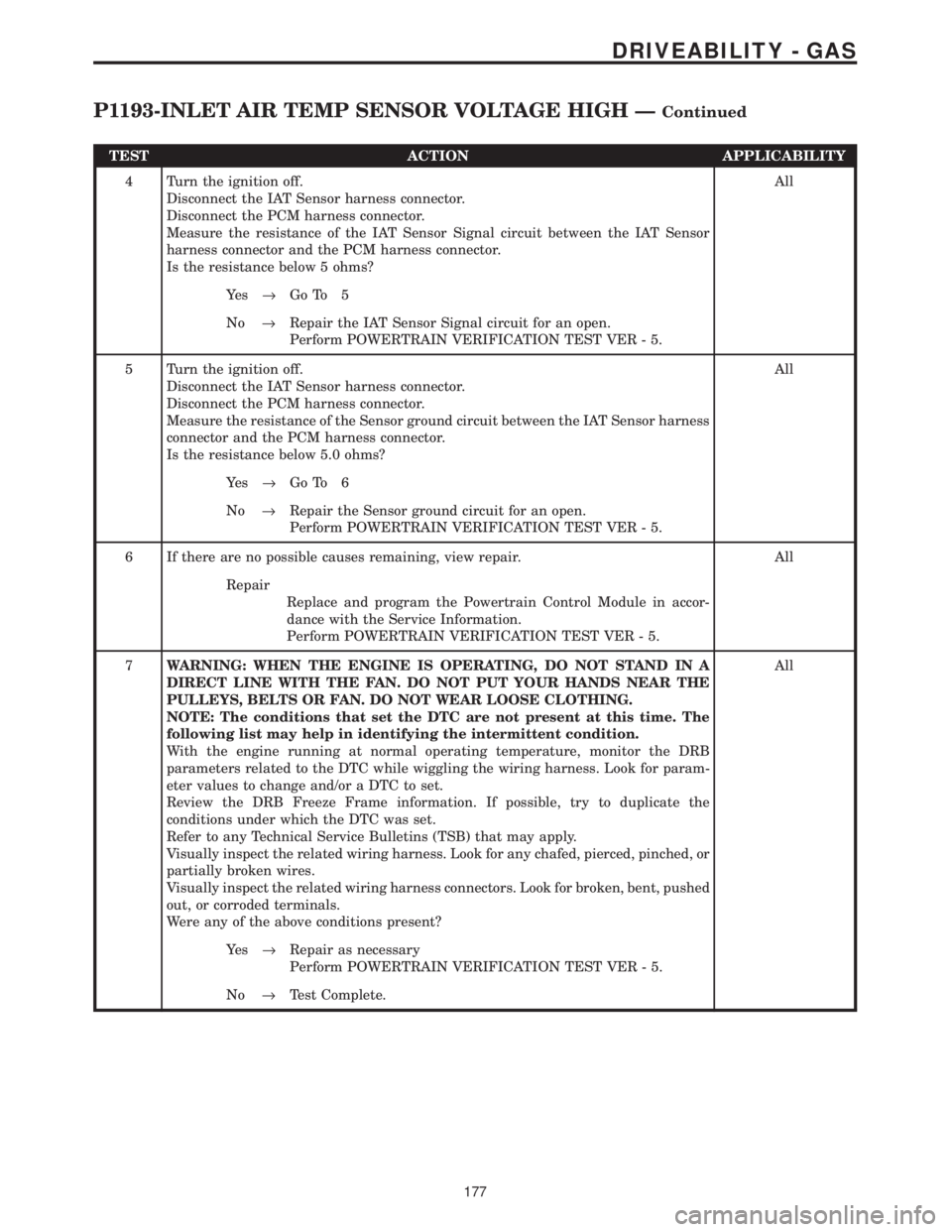
TEST ACTION APPLICABILITY
4 Turn the ignition off.
Disconnect the IAT Sensor harness connector.
Disconnect the PCM harness connector.
Measure the resistance of the IAT Sensor Signal circuit between the IAT Sensor
harness connector and the PCM harness connector.
Is the resistance below 5 ohms?All
Ye s®Go To 5
No®Repair the IAT Sensor Signal circuit for an open.
Perform POWERTRAIN VERIFICATION TEST VER - 5.
5 Turn the ignition off.
Disconnect the IAT Sensor harness connector.
Disconnect the PCM harness connector.
Measure the resistance of the Sensor ground circuit between the IAT Sensor harness
connector and the PCM harness connector.
Is the resistance below 5.0 ohms?All
Ye s®Go To 6
No®Repair the Sensor ground circuit for an open.
Perform POWERTRAIN VERIFICATION TEST VER - 5.
6 If there are no possible causes remaining, view repair. All
Repair
Replace and program the Powertrain Control Module in accor-
dance with the Service Information.
Perform POWERTRAIN VERIFICATION TEST VER - 5.
7WARNING: WHEN THE ENGINE IS OPERATING, DO NOT STAND IN A
DIRECT LINE WITH THE FAN. DO NOT PUT YOUR HANDS NEAR THE
PULLEYS, BELTS OR FAN. DO NOT WEAR LOOSE CLOTHING.
NOTE: The conditions that set the DTC are not present at this time. The
following list may help in identifying the intermittent condition.
With the engine running at normal operating temperature, monitor the DRB
parameters related to the DTC while wiggling the wiring harness. Look for param-
eter values to change and/or a DTC to set.
Review the DRB Freeze Frame information. If possible, try to duplicate the
conditions under which the DTC was set.
Refer to any Technical Service Bulletins (TSB) that may apply.
Visually inspect the related wiring harness. Look for any chafed, pierced, pinched, or
partially broken wires.
Visually inspect the related wiring harness connectors. Look for broken, bent, pushed
out, or corroded terminals.
Were any of the above conditions present?All
Ye s®Repair as necessary
Perform POWERTRAIN VERIFICATION TEST VER - 5.
No®Test Complete.
177
DRIVEABILITY - GAS
P1193-INLET AIR TEMP SENSOR VOLTAGE HIGH ÐContinued
Page 3972 of 4284
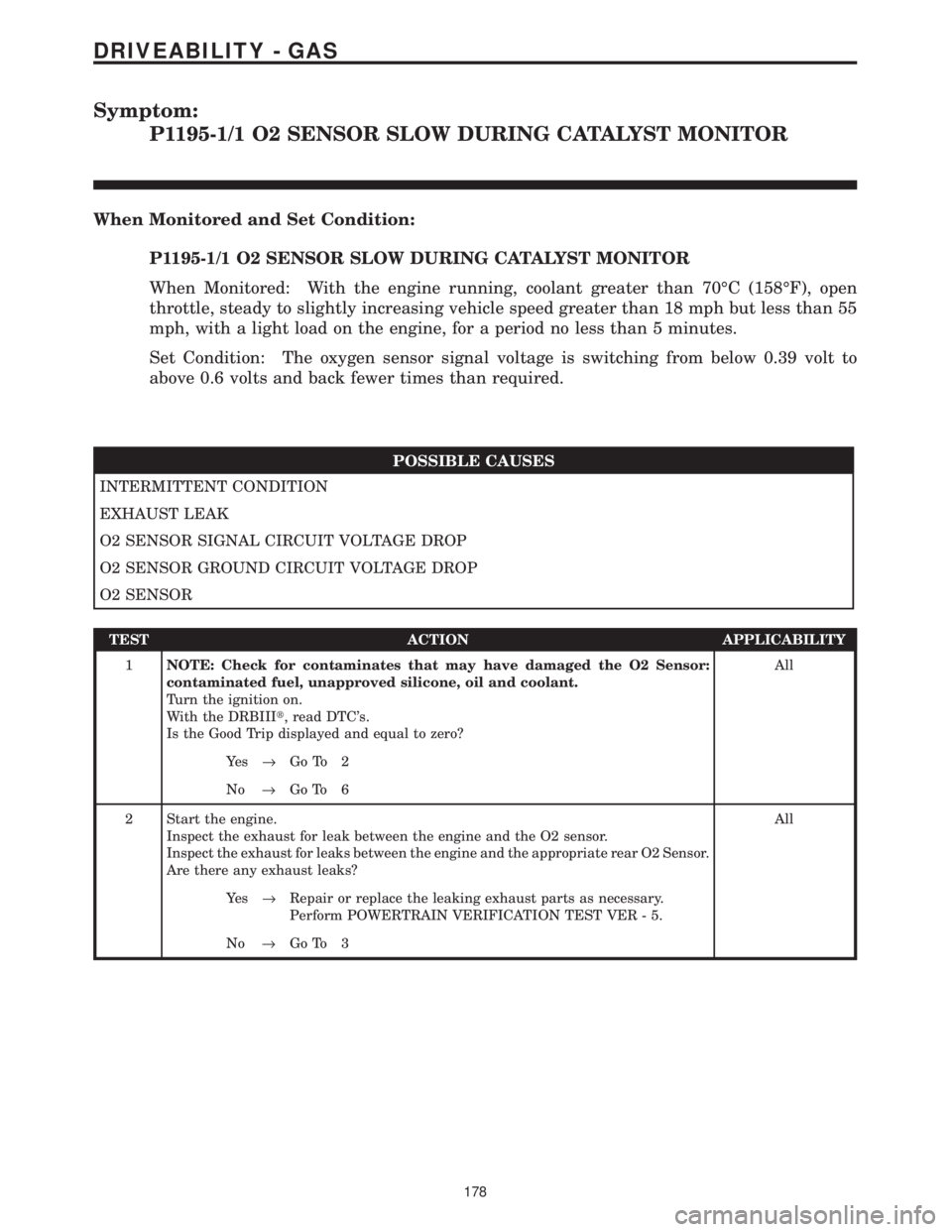
Symptom:
P1195-1/1 O2 SENSOR SLOW DURING CATALYST MONITOR
When Monitored and Set Condition:
P1195-1/1 O2 SENSOR SLOW DURING CATALYST MONITOR
When Monitored: With the engine running, coolant greater than 70ÉC (158ÉF), open
throttle, steady to slightly increasing vehicle speed greater than 18 mph but less than 55
mph, with a light load on the engine, for a period no less than 5 minutes.
Set Condition: The oxygen sensor signal voltage is switching from below 0.39 volt to
above 0.6 volts and back fewer times than required.
POSSIBLE CAUSES
INTERMITTENT CONDITION
EXHAUST LEAK
O2 SENSOR SIGNAL CIRCUIT VOLTAGE DROP
O2 SENSOR GROUND CIRCUIT VOLTAGE DROP
O2 SENSOR
TEST ACTION APPLICABILITY
1NOTE: Check for contaminates that may have damaged the O2 Sensor:
contaminated fuel, unapproved silicone, oil and coolant.
Turn the ignition on.
With the DRBIIIt, read DTC's.
Is the Good Trip displayed and equal to zero?All
Ye s®Go To 2
No®Go To 6
2 Start the engine.
Inspect the exhaust for leak between the engine and the O2 sensor.
Inspect the exhaust for leaks between the engine and the appropriate rear O2 Sensor.
Are there any exhaust leaks?All
Ye s®Repair or replace the leaking exhaust parts as necessary.
Perform POWERTRAIN VERIFICATION TEST VER - 5.
No®Go To 3
178
DRIVEABILITY - GAS
Page 3973 of 4284
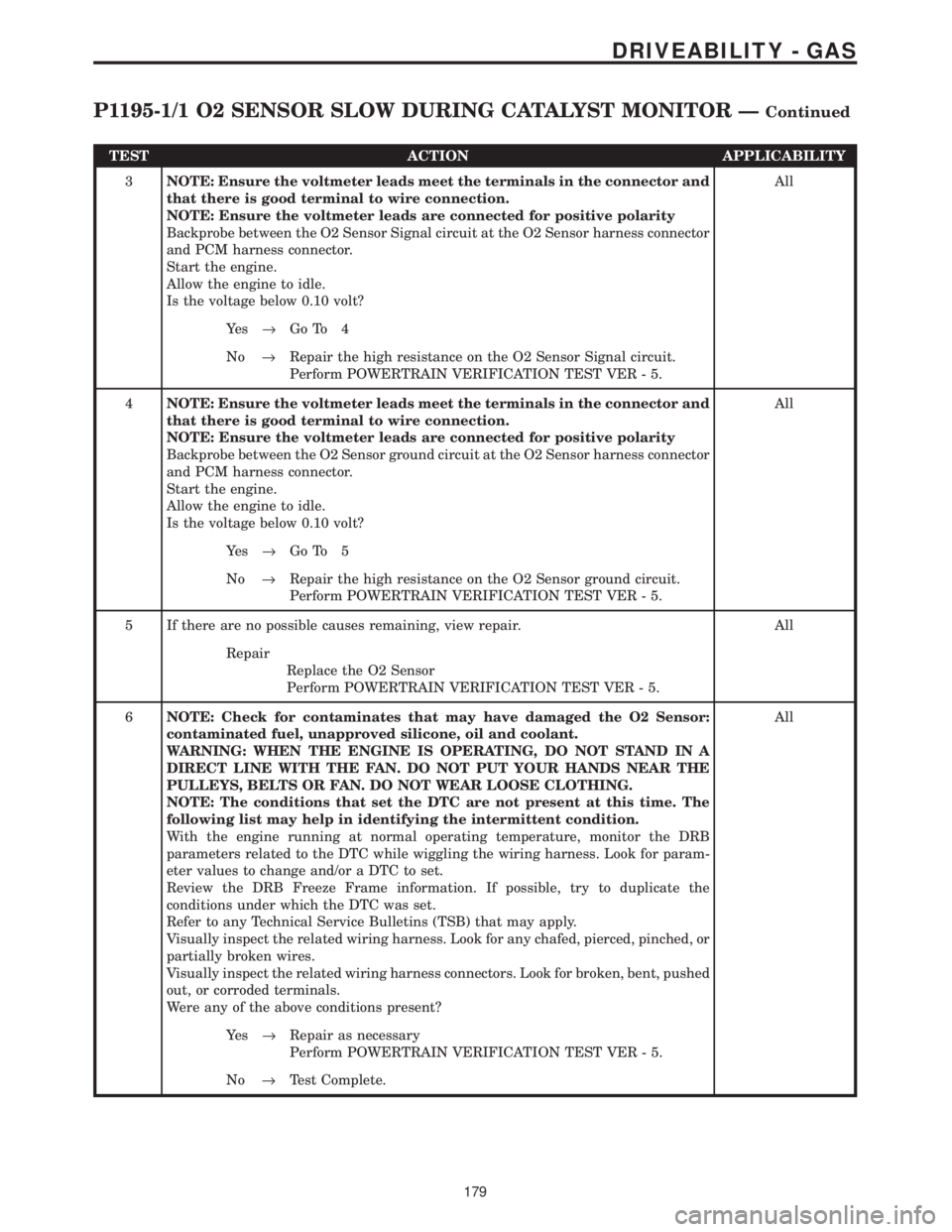
TEST ACTION APPLICABILITY
3NOTE: Ensure the voltmeter leads meet the terminals in the connector and
that there is good terminal to wire connection.
NOTE: Ensure the voltmeter leads are connected for positive polarity
Backprobe between the O2 Sensor Signal circuit at the O2 Sensor harness connector
and PCM harness connector.
Start the engine.
Allow the engine to idle.
Is the voltage below 0.10 volt?All
Ye s®Go To 4
No®Repair the high resistance on the O2 Sensor Signal circuit.
Perform POWERTRAIN VERIFICATION TEST VER - 5.
4NOTE: Ensure the voltmeter leads meet the terminals in the connector and
that there is good terminal to wire connection.
NOTE: Ensure the voltmeter leads are connected for positive polarity
Backprobe between the O2 Sensor ground circuit at the O2 Sensor harness connector
and PCM harness connector.
Start the engine.
Allow the engine to idle.
Is the voltage below 0.10 volt?All
Ye s®Go To 5
No®Repair the high resistance on the O2 Sensor ground circuit.
Perform POWERTRAIN VERIFICATION TEST VER - 5.
5 If there are no possible causes remaining, view repair. All
Repair
Replace the O2 Sensor
Perform POWERTRAIN VERIFICATION TEST VER - 5.
6NOTE: Check for contaminates that may have damaged the O2 Sensor:
contaminated fuel, unapproved silicone, oil and coolant.
WARNING: WHEN THE ENGINE IS OPERATING, DO NOT STAND IN A
DIRECT LINE WITH THE FAN. DO NOT PUT YOUR HANDS NEAR THE
PULLEYS, BELTS OR FAN. DO NOT WEAR LOOSE CLOTHING.
NOTE: The conditions that set the DTC are not present at this time. The
following list may help in identifying the intermittent condition.
With the engine running at normal operating temperature, monitor the DRB
parameters related to the DTC while wiggling the wiring harness. Look for param-
eter values to change and/or a DTC to set.
Review the DRB Freeze Frame information. If possible, try to duplicate the
conditions under which the DTC was set.
Refer to any Technical Service Bulletins (TSB) that may apply.
Visually inspect the related wiring harness. Look for any chafed, pierced, pinched, or
partially broken wires.
Visually inspect the related wiring harness connectors. Look for broken, bent, pushed
out, or corroded terminals.
Were any of the above conditions present?All
Ye s®Repair as necessary
Perform POWERTRAIN VERIFICATION TEST VER - 5.
No®Test Complete.
179
DRIVEABILITY - GAS
P1195-1/1 O2 SENSOR SLOW DURING CATALYST MONITOR ÐContinued
Page 3974 of 4284
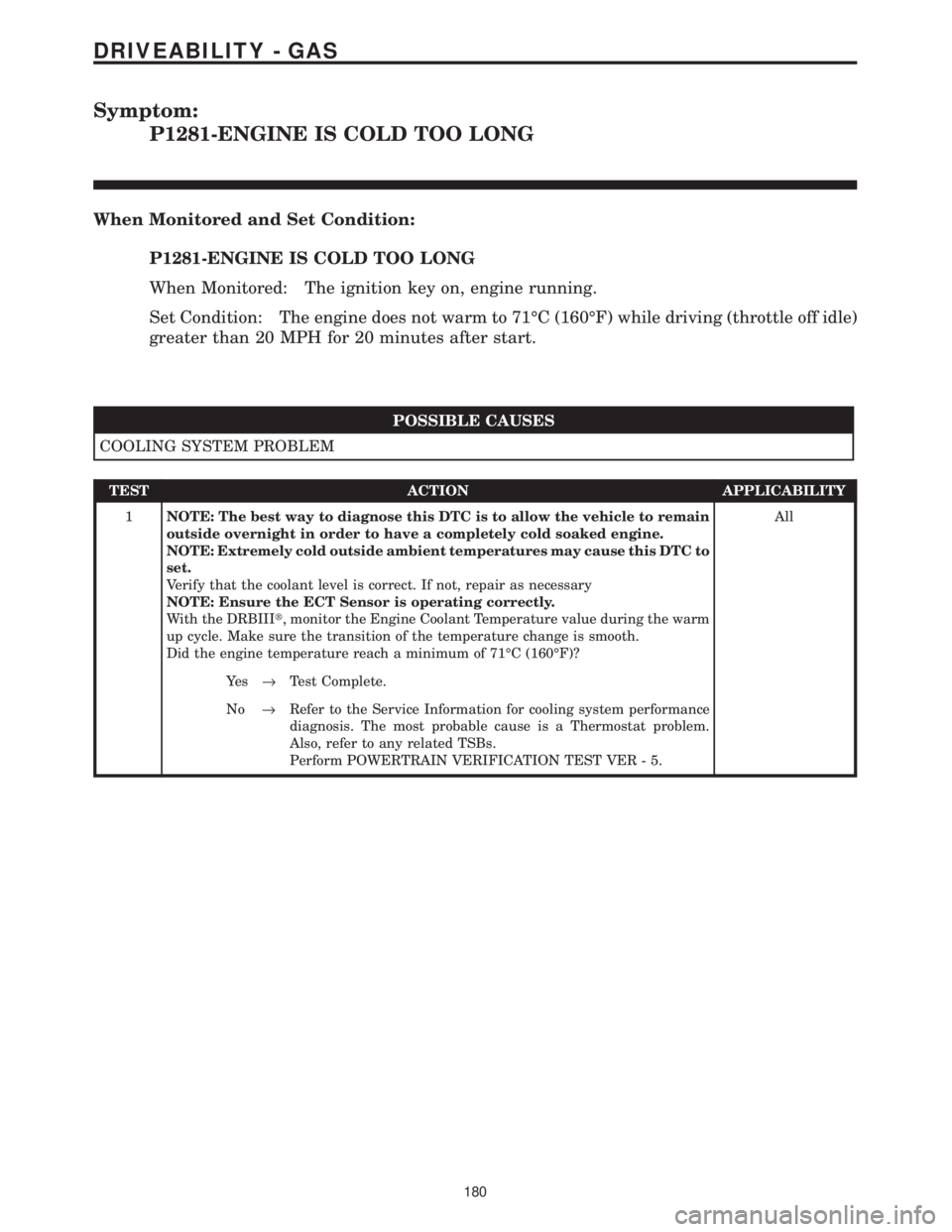
Symptom:
P1281-ENGINE IS COLD TOO LONG
When Monitored and Set Condition:
P1281-ENGINE IS COLD TOO LONG
When Monitored: The ignition key on, engine running.
Set Condition: The engine does not warm to 71ÉC (160ÉF) while driving (throttle off idle)
greater than 20 MPH for 20 minutes after start.
POSSIBLE CAUSES
COOLING SYSTEM PROBLEM
TEST ACTION APPLICABILITY
1NOTE: The best way to diagnose this DTC is to allow the vehicle to remain
outside overnight in order to have a completely cold soaked engine.
NOTE: Extremely cold outside ambient temperatures may cause this DTC to
set.
Verify that the coolant level is correct. If not, repair as necessary
NOTE: Ensure the ECT Sensor is operating correctly.
With the DRBIIIt, monitor the Engine Coolant Temperature value during the warm
up cycle. Make sure the transition of the temperature change is smooth.
Did the engine temperature reach a minimum of 71ÉC (160ÉF)?All
Ye s®Test Complete.
No®Refer to the Service Information for cooling system performance
diagnosis. The most probable cause is a Thermostat problem.
Also, refer to any related TSBs.
Perform POWERTRAIN VERIFICATION TEST VER - 5.
180
DRIVEABILITY - GAS
Page 3978 of 4284
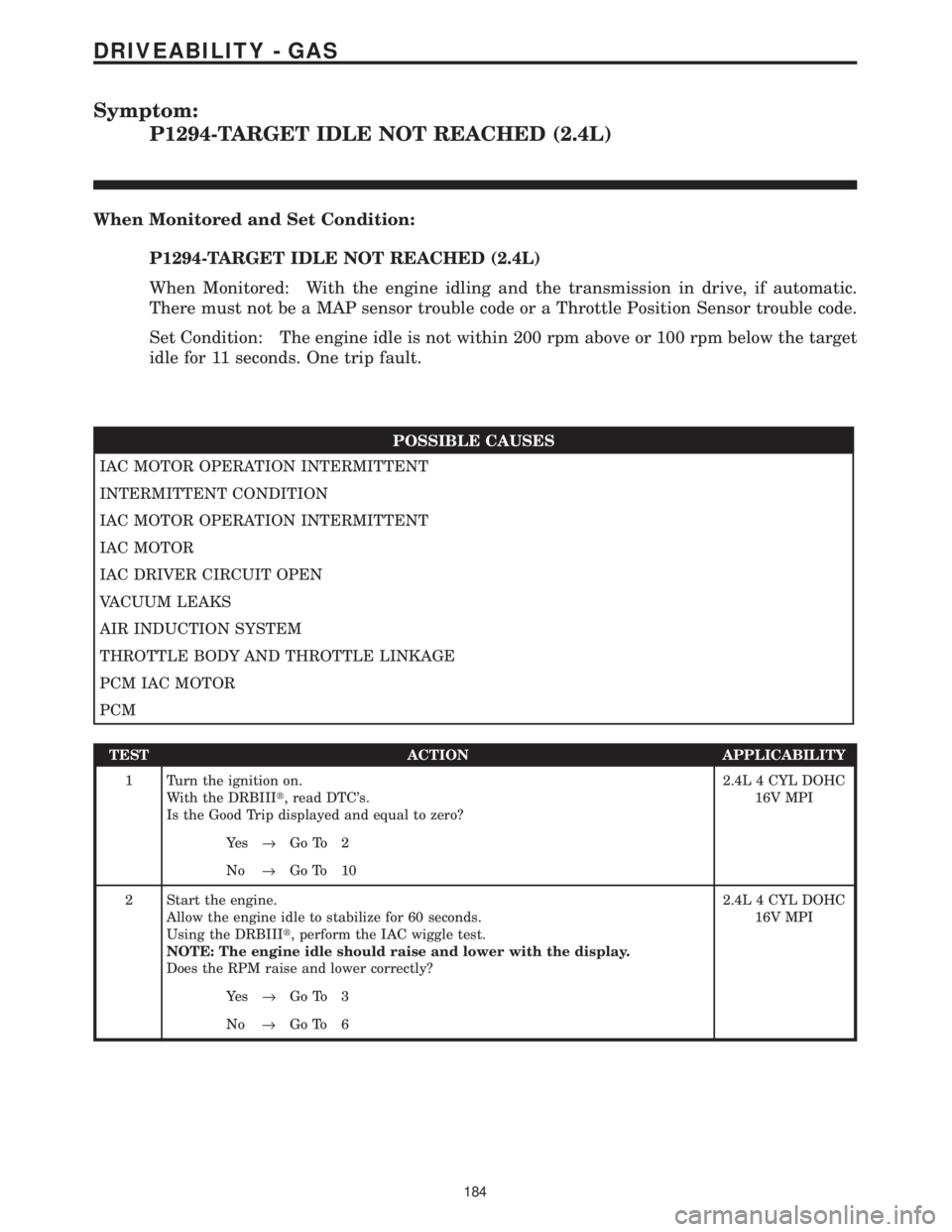
Symptom:
P1294-TARGET IDLE NOT REACHED (2.4L)
When Monitored and Set Condition:
P1294-TARGET IDLE NOT REACHED (2.4L)
When Monitored: With the engine idling and the transmission in drive, if automatic.
There must not be a MAP sensor trouble code or a Throttle Position Sensor trouble code.
Set Condition: The engine idle is not within 200 rpm above or 100 rpm below the target
idle for 11 seconds. One trip fault.
POSSIBLE CAUSES
IAC MOTOR OPERATION INTERMITTENT
INTERMITTENT CONDITION
IAC MOTOR OPERATION INTERMITTENT
IAC MOTOR
IAC DRIVER CIRCUIT OPEN
VACUUM LEAKS
AIR INDUCTION SYSTEM
THROTTLE BODY AND THROTTLE LINKAGE
PCM IAC MOTOR
PCM
TEST ACTION APPLICABILITY
1 Turn the ignition on.
With the DRBIIIt, read DTC's.
Is the Good Trip displayed and equal to zero?2.4L 4 CYL DOHC
16V MPI
Ye s®Go To 2
No®Go To 10
2 Start the engine.
Allow the engine idle to stabilize for 60 seconds.
Using the DRBIIIt, perform the IAC wiggle test.
NOTE: The engine idle should raise and lower with the display.
Does the RPM raise and lower correctly?2.4L 4 CYL DOHC
16V MPI
Ye s®Go To 3
No®Go To 6
184
DRIVEABILITY - GAS
Page 3981 of 4284
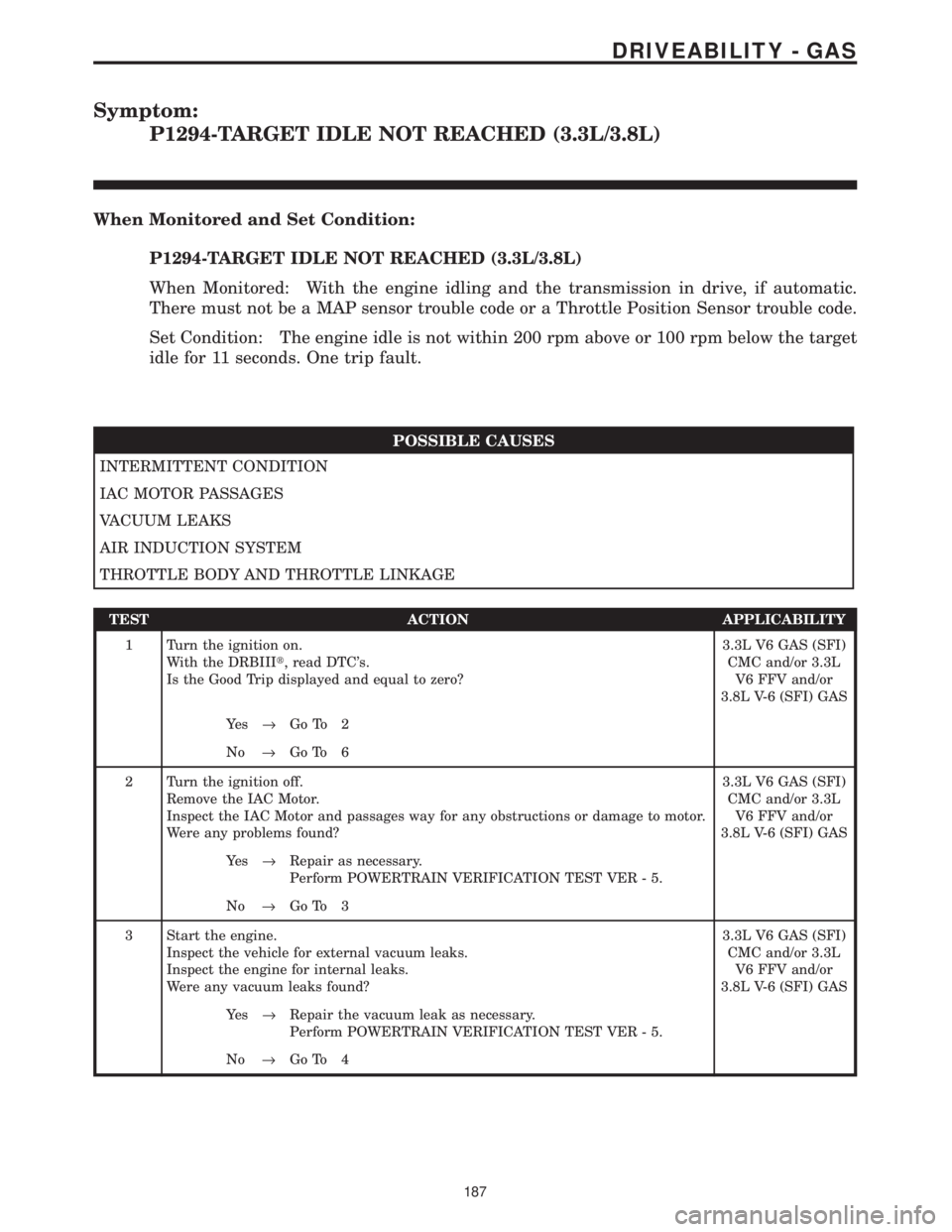
Symptom:
P1294-TARGET IDLE NOT REACHED (3.3L/3.8L)
When Monitored and Set Condition:
P1294-TARGET IDLE NOT REACHED (3.3L/3.8L)
When Monitored: With the engine idling and the transmission in drive, if automatic.
There must not be a MAP sensor trouble code or a Throttle Position Sensor trouble code.
Set Condition: The engine idle is not within 200 rpm above or 100 rpm below the target
idle for 11 seconds. One trip fault.
POSSIBLE CAUSES
INTERMITTENT CONDITION
IAC MOTOR PASSAGES
VACUUM LEAKS
AIR INDUCTION SYSTEM
THROTTLE BODY AND THROTTLE LINKAGE
TEST ACTION APPLICABILITY
1 Turn the ignition on.
With the DRBIIIt, read DTC's.
Is the Good Trip displayed and equal to zero?3.3L V6 GAS (SFI)
CMC and/or 3.3L
V6 FFV and/or
3.8L V-6 (SFI) GAS
Ye s®Go To 2
No®Go To 6
2 Turn the ignition off.
Remove the IAC Motor.
Inspect the IAC Motor and passages way for any obstructions or damage to motor.
Were any problems found?3.3L V6 GAS (SFI)
CMC and/or 3.3L
V6 FFV and/or
3.8L V-6 (SFI) GAS
Ye s®Repair as necessary.
Perform POWERTRAIN VERIFICATION TEST VER - 5.
No®Go To 3
3 Start the engine.
Inspect the vehicle for external vacuum leaks.
Inspect the engine for internal leaks.
Were any vacuum leaks found?3.3L V6 GAS (SFI)
CMC and/or 3.3L
V6 FFV and/or
3.8L V-6 (SFI) GAS
Ye s®Repair the vacuum leak as necessary.
Perform POWERTRAIN VERIFICATION TEST VER - 5.
No®Go To 4
187
DRIVEABILITY - GAS
Page 3983 of 4284
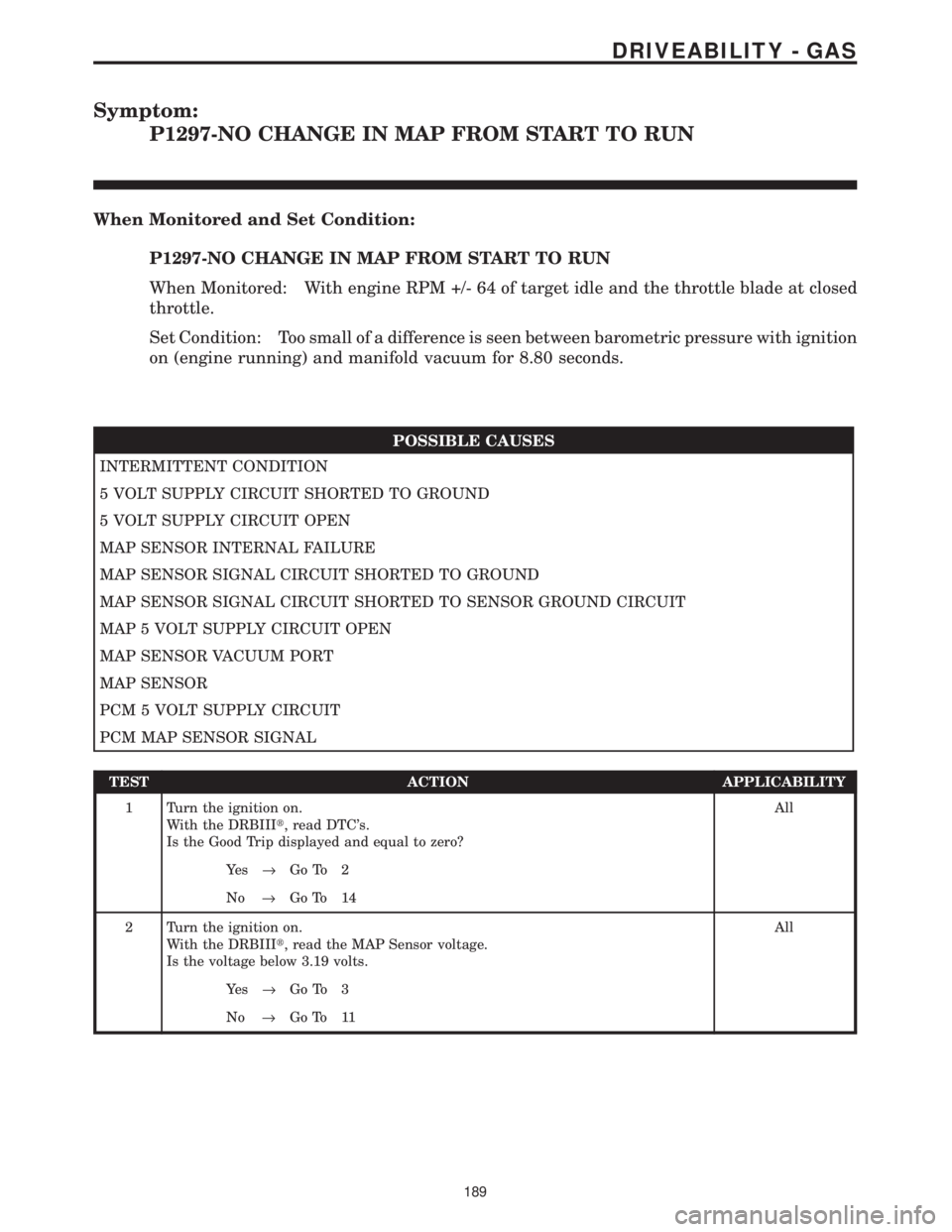
Symptom:
P1297-NO CHANGE IN MAP FROM START TO RUN
When Monitored and Set Condition:
P1297-NO CHANGE IN MAP FROM START TO RUN
When Monitored: With engine RPM +/- 64 of target idle and the throttle blade at closed
throttle.
Set Condition: Too small of a difference is seen between barometric pressure with ignition
on (engine running) and manifold vacuum for 8.80 seconds.
POSSIBLE CAUSES
INTERMITTENT CONDITION
5 VOLT SUPPLY CIRCUIT SHORTED TO GROUND
5 VOLT SUPPLY CIRCUIT OPEN
MAP SENSOR INTERNAL FAILURE
MAP SENSOR SIGNAL CIRCUIT SHORTED TO GROUND
MAP SENSOR SIGNAL CIRCUIT SHORTED TO SENSOR GROUND CIRCUIT
MAP 5 VOLT SUPPLY CIRCUIT OPEN
MAP SENSOR VACUUM PORT
MAP SENSOR
PCM 5 VOLT SUPPLY CIRCUIT
PCM MAP SENSOR SIGNAL
TEST ACTION APPLICABILITY
1 Turn the ignition on.
With the DRBIIIt, read DTC's.
Is the Good Trip displayed and equal to zero?All
Ye s®Go To 2
No®Go To 14
2 Turn the ignition on.
With the DRBIIIt, read the MAP Sensor voltage.
Is the voltage below 3.19 volts.All
Ye s®Go To 3
No®Go To 11
189
DRIVEABILITY - GAS